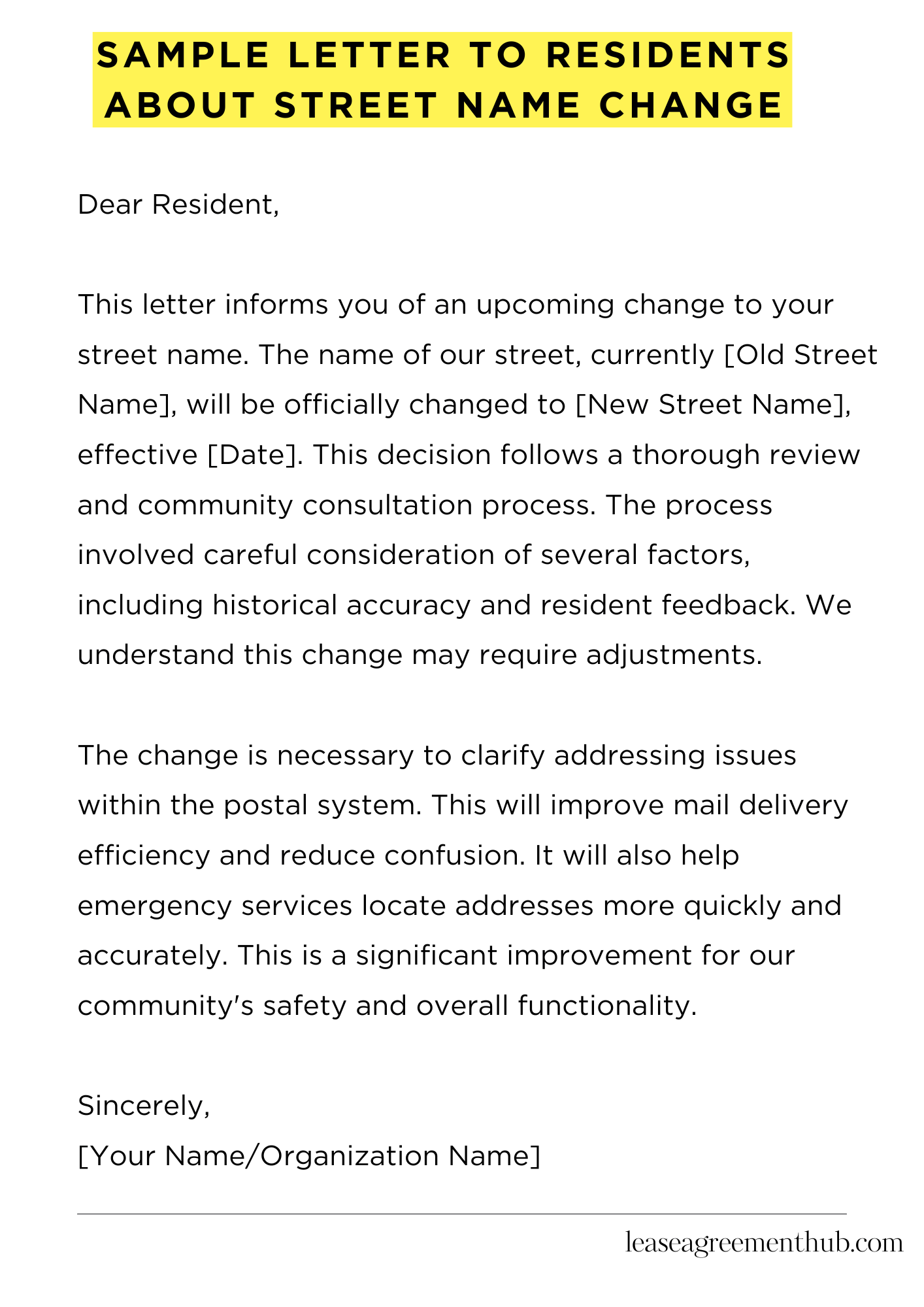This blog post is about letters. These letters tell residents about street name changes. The purpose is clear communication.
We’ll give you examples of these letters. These are templates. You can use them to write your own. They’ll make writing easier.
These samples are ready to use. They’re helpful and easy to adapt. Save time and write a great letter.
Sample Letter to Residents About Street Name Change
[Your Name/Organization Name]
[Your Address]
[Your Phone Number]
[Your Email Address]
[Date]
Dear Resident,
This letter informs you of an upcoming change to your street name. The name of our street, currently [Old Street Name], will be officially changed to [New Street Name], effective [Date]. This decision follows a thorough review and community consultation process. The process involved careful consideration of several factors, including historical accuracy and resident feedback. We understand this change may require adjustments.
The change is necessary to clarify addressing issues within the postal system. This will improve mail delivery efficiency and reduce confusion. It will also help emergency services locate addresses more quickly and accurately. This is a significant improvement for our community’s safety and overall functionality.
To ensure a smooth transition, we will be providing updated address labels and information packets to each household. You should receive these within the next two weeks. These packets will contain all the necessary information to update your address with various services. This includes banks, utility companies, and government agencies. Please keep an eye out for this important package.
We understand that changing a street name can be disruptive. Therefore, we are committed to assisting you throughout this process. If you have any questions or require any assistance, please do not hesitate to contact us. We are here to help. You can reach us at the contact information listed above.
We appreciate your patience and understanding as we implement this necessary change. We believe this will ultimately benefit our entire community.
Sincerely,
[Your Name/Organization Name]

How to Write a Sample Letter to Residents About Street Name Change
Initiating the Correspondence: Establishing Credibility and Tone
The initial salutation is paramount. Avoid generic openings; instead, strive for a personalized approach. Using the residents’ names, if possible, fosters a sense of individual engagement. Your introduction should clearly state the purpose of the letter—the proposed street name change. Establish your credentials early, subtly highlighting your authority or affiliation with the relevant governing body. This authoritative start preempts potential resistance and frames the conversation constructively.
Articulating the Rationale: Justifying the Impending Change
Transparency is key. Elucidate the reasons behind the proposed nomenclature alteration. Are there historical inaccuracies to rectify? Does the current name present logistical challenges for emergency services? Perhaps a more evocative or geographically appropriate name is sought. Clearly and concisely articulate your justifications using precise language. Avoid obfuscation or jargon; use plain English to ensure complete comprehension. A compelling rationale is the cornerstone of acceptance.
Presenting the Proposed Name: A Detailed Explanation
Introduce the new proposed name with a succinct, yet descriptive explanation. Detail the etymology or inspiration behind the chosen moniker. Consider adding historical context or local significance if applicable. This section should be eloquent, demonstrating thoughtful consideration in the selection process. A well-presented argument for the new name will allay concerns and enhance credibility.
Addressing Potential Concerns: Preempting Objections
Anticipate resident concerns. Will the change necessitate costly address updates? What about the potential disruption to established postal services? Addressing these potential objections proactively demonstrates forethought and mitigates potential backlash. Directly addressing logistical challenges with concrete solutions builds trust and fosters collaboration. This proactive approach showcases a comprehensive understanding of the process.
Outlining the Implementation Plan: A Roadmap for Action
Provide a clear timeline for the implementation of the street name change. Specify key dates, processes, and responsibilities. Include contact information for relevant authorities for questions or clarifications. A well-defined plan minimizes uncertainty and fosters a sense of control, assuaging resident apprehension.
Facilitating Feedback and Engagement: Fostering Dialogue
Include clear instructions on how residents can provide feedback or raise concerns. Specify a deadline for responses and how they should be submitted (e.g., email, postal mail, online form). Encourage open communication, actively soliciting input to demonstrate responsiveness to community needs. This participatory approach is crucial for building consensus and fostering a spirit of collaboration.
Concluding with a Call to Action: Solidifying the Next Steps
Reiterate the importance of the name change and restate the benefits. End with a polite, yet assertive, call to action, encouraging residents to actively engage in the process. Maintain a professional and courteous tone throughout the correspondence. A well-crafted conclusion leaves a lasting positive impression and encourages a receptive response.
FAQs about sample letter to residents about street name change
What information should be included in a letter announcing a street name change?
A letter announcing a street name change should include the old street name, the new street name, the effective date of the change, the reason for the change (if applicable), contact information for inquiries or concerns, and information about how the change will affect residents (e.g., updating addresses on licenses, etc.).
How formal should the tone of the letter be?
The tone should be formal yet approachable. Maintain a professional and respectful tone while ensuring clarity and understanding for all residents.
What is the best way to distribute the letter to residents?
Distribution methods can include direct mail delivery, posting in community centers or common areas, and potentially through local news outlets or community websites. Consider the demographics of your community to determine the most effective method.
Should the letter include a map showing the affected area?
Including a map, especially for larger areas or complex changes, is highly recommended to avoid confusion and ensure all affected residents are clearly identified.
What should I do if residents have questions or concerns after receiving the letter?
Provide clear contact information (phone number, email address, website) and specify designated individuals or departments responsible for addressing resident inquiries. Establish a system for collecting and addressing feedback.
Related: